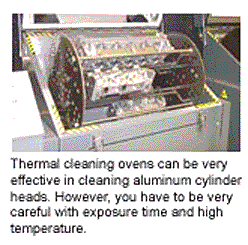Engine rebuilding may be your career, but component cleaning may be one of your biggest jobs. Ever since the earliest days when engine builders had only a hot tank and a solvent sink to clean their parts they have been looking for better methods to get parts clean. Back then, most parts were cast iron and steel. Today aluminum heads represent a growing proportion of many shops’ businesses. However, aluminum presents unique cleaning challenges to the rebuilder for many reasons and the equipment to clean older parts was not designed to handle today’s alloys. The various composites inherent in aluminum make it more difficult to clean if you rely on cast iron cleaning methods.
One of the biggest issues surrounding aluminum cleaning is how to get it clean with as little involvement from your personnel as possible? This month, we will look at different methods of cleaning aluminum and talk to engine builders about what they use and what works for them.
Keep in mind that every shop is unique. One method of cleaning aluminum may work great for one shop and not at all for another. A small one-man shop is obviously going to have vastly different resources and priorities than a large remanufacturer. We are not endorsing or promoting any particular method of cleaning over another. No matter what system you use, finding something that works for you is the key.

Some rebuilders have been struggling to find effective ways to clean aluminum for years.
For Ault & James Engine Rebuilders, Dayton, OH, the volume of aluminum has become quite significant over the past few years. At least half of the heads Jerry Ault rebuilds are aluminum. While cylinder head work is not his primary business – his shop does build a lot of long blocks – he does sell heads individually. And the majority of the heads Ault sells individually are aluminum, too.
“We’ve tried cleaning aluminum several different ways, including the thermal method and it didn’t really work for us,” explains Jerry Ault.
“We faced so much shot retention that we ended up spending as many man-hours trying to clean up the piece afterwards as we did cleaning it.”
Ault says he prefers to clean aluminum the old fashioned way: by dipping the part in a hot tank chemical bath and then removing whatever doesn’t come off there using a glass bead machine. “It’s less time consuming for us,” says Ault. “And you don’t have to spend a lot of time masking or blocking off passages to keep shot out. Of course, you still have deal with retention of glass bead, but it’s the method that works for us.”
According to rebuilders we spoke with, there’s no shortcut to cleaning aluminum. “I’ve looked fairly hard over the last 10 years to find a better, faster way for our shop to clean aluminum and there’s really nothing I’ve found that’s better than the way we’ve been doing it,” says Ault.
Put Some Heat In It
Using an oven to clean aluminum can be done successfully according to experts, but you must use plenty of caution when it comes to temperature. Aluminum will anneal at high temperatures and long exposure to high heat.
One of the keys to cleaning aluminum with a thermal system is to dry the oil deposits to a dried ash state. Some manufacturers offer ovens that use indirect flame in a convection process. Convection is considered a safe way to clean aluminum because it’s an indirect flame that basically stirs hot air around the part, uniformly heating the aluminum so there’s less chance of annealing the part.
According to some experts there is a lot of misinformation about what can and can’t be done when it comes to heating aluminum. There are a couple of ways that aluminum becomes annealed. One way is if the aluminum part reaches 600













